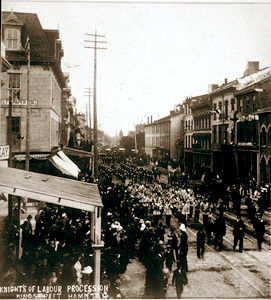
Canadian Federation of Labour
The Canadian Federation of Labour (National Trades and Labor Congress until 1908) was founded in 1902 as a solely Canadian body dedicated to national organization. Its founding bodies were the Knights of Labor and the national unions of shoemakers, cigar makers, painters and carpenters, which had been ousted from the Trades and Labour Congress in 1902 after the latter, dominated by the American Federation of Labor, rejected dual unionism by refusing to recognize a national union where an international union existed. This decision created bitter divisions in the Canadian trade-union movement.
The CFL remained weak. At its 1911 conference, for example, only 17 unions were represented, and the delegates were mainly from Québec and the Provincial Workmen's Association of Nova Scotia. There were many reasons: its conservatism and attitude toward strikes alienated unionists who might otherwise have been more supportive; it faced fierce opposition from the AFL, which regarded dual unionism as anathema; and it concentrated on luring members from rival unions instead of promoting unions among unorganized workers. In 1927 the CFL became a founding member of the All-Canadian Congress of Labour.
In 1982 a group of construction unions covering approximately 200 000 members united to form a new Canadian Federation of Labour. These unions had been suspended from the Canadian Labour Congress for nonpayment of per capita tax. The two bodies differed on matters of representation at CLC conventions, dual unionism and the CLC standard that Canadian officers of affiliated unions be elected by the Canadian membership. The CFL philosophy is summed up in the statement of its president, James McCambly: "We are committed to leaving politics to the politicians and to concentrating on being effective representatives of labour's interest within the political system." By 1996 CFL membership had shrunk to 140 000 as some of its affiliates rejoined the CLC. In 1997 merger discussions were taking place between the two labour centrals.

 Share on Facebook
Share on Facebook Share on X
Share on X Share by Email
Share by Email Share on Google Classroom
Share on Google Classroom


